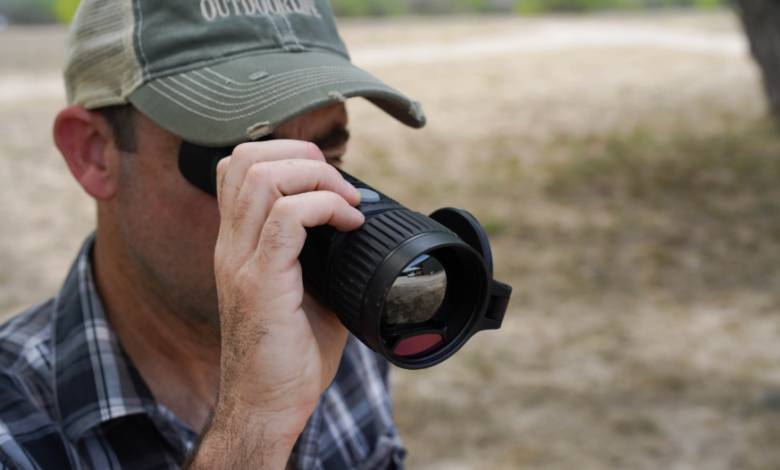Exploring the Modern Uses of a Thermal Monocular in Outdoor and Tactical Scenarios

In the world of advanced optics, the thermal monocular stands as a powerful tool that has revolutionized visibility in darkness and obscured environments. Designed to detect infrared radiation or heat emitted by objects, this compact device is widely appreciated by hunters, law enforcement personnel, military operatives, wildlife observers, and even outdoor enthusiasts. Unlike traditional night vision that relies on ambient light, the thermal monocular provides real-time imaging based on temperature differences—allowing users to “see” heat signatures, whether in pitch black, fog, smoke, or foliage.
In this comprehensive article, we delve into what a thermal monocular is, how it functions, where it’s used, and why it has become an indispensable gadget for many industries and individuals.
What Is a Thermal Monocular?
A thermal monocular is a handheld, single-lens imaging device that uses infrared sensors to detect temperature variations and transform them into visible images. These devices are engineered to be lightweight and portable, making them ideal for single-handed use in the field. Unlike binoculars, which offer two viewing lenses, monoculars are designed for one eye—providing simplicity, compactness, and ease of use.
Modern thermal monoculars typically include features like high-resolution OLED displays, digital zoom, video recording capabilities, image storage, Wi-Fi streaming, and waterproof housing. These features make them versatile for both daytime and nighttime operations.
How a Thermal Monocular Works
The thermal monocular operates based on the principle of thermography. Every object—whether living or non-living—emits infrared radiation if its temperature is above absolute zero. The monocular’s infrared detector captures this radiation and converts it into a digital image. Warmer objects appear brighter or differently colored than cooler ones, depending on the chosen color palette (e.g., white-hot, black-hot, red-hot).
This ability to detect heat and not just light allows users to visualize objects through darkness, camouflage, fog, or even thin walls. This makes it especially valuable for tactical and search-and-rescue missions.
See also: How Do Tech Companies Source Critical CPU Components?
Key Applications of a Thermal Monocular
1. Hunting and Wildlife Observation
Hunters commonly use a thermal monocular to spot game animals in low-light conditions or dense vegetation. Unlike traditional spotlights or night vision scopes, thermal imaging does not alert or scare animals, offering a stealth advantage. Wildlife photographers and researchers also employ thermal monoculars to monitor nocturnal behaviors without disturbing natural habitats.
2. Law Enforcement and Surveillance
Police departments and private security firms rely on thermal monoculars for surveillance, search-and-rescue operations, perimeter monitoring, and fugitive tracking. The device helps detect human presence behind obstacles, in wooded areas, or during nighttime pursuits. Its real-time heat detection plays a critical role in enhancing situational awareness.
3. Military and Tactical Operations
In military settings, a thermal monocular is standard equipment for night missions and battlefield reconnaissance. It aids soldiers in identifying enemy positions, booby traps, or hidden threats during low-visibility scenarios. The tactical edge provided by thermal monoculars can mean the difference between mission success and failure.
4. Home and Property Security
Homeowners and property managers use handheld thermal monoculars to inspect perimeters, detect intruders, or identify heat leaks in buildings. These tools are also utilized by electricians and HVAC professionals to check for electrical hotspots, insulation gaps, or system malfunctions.
5. Emergency and Rescue Services
Firefighters and first responders use thermal monoculars to navigate through smoke-filled environments, locate trapped individuals, or assess hazardous areas. These devices are particularly effective during natural disasters or building collapses when time is critical and visibility is poor.
Advantages of Using a Thermal Monocular
- All-Light Capability: Unlike traditional night vision that needs moonlight or artificial illumination, a thermal monocular functions flawlessly in complete darkness.
- Penetration Through Obstacles: It can detect heat signatures through fog, smoke, and thin materials, offering enhanced visibility in harsh conditions.
- Compact and Lightweight: Most thermal monoculars are small and easy to carry, ideal for quick deployment and single-hand operation.
- Non-Invasive Detection: The device allows for silent and hidden observation, minimizing disruption to wildlife or alerting suspects.
- Durability: Designed for rugged use, thermal monoculars often come with waterproof and shockproof features, suitable for extreme environments.
Features to Consider When Buying a Thermal Monocular
Before purchasing a thermal monocular, it’s important to understand the key features that affect performance and usability:
- Resolution: Higher resolution offers clearer and more detailed images. Choose a device with at least 320×240 or 640×480 resolution for reliable clarity.
- Refresh Rate: A faster refresh rate (30Hz or 60Hz) ensures smoother motion tracking, especially when observing moving subjects.
- Detection Range: Depending on your needs, opt for a model with sufficient detection range—short-range (under 300 yards) for personal use, or long-range (up to 2000 yards) for tactical/military applications.
- Battery Life: Look for units with long-lasting batteries (up to 8 hours or more) to avoid frequent interruptions.
- Color Palettes: Multiple color schemes like white-hot, black-hot, or rainbow allow users to adjust the display for better contrast and target recognition.
- Recording Capability: Built-in video or image recording helps document findings for later analysis or evidence.
Popular Brands in the Market
Some of the most reputable manufacturers of thermal monocular devices include:
- FLIR Systems – Known for their broad range of compact thermal imagers for both consumers and professionals.
- Pulsar – Offers advanced models with wireless streaming, high-resolution sensors, and rugged construction.
- ATN Corp – Features smart monoculars with integrated GPS, Wi-Fi, and recording.
- AGM Global Vision – Specializes in military-grade optics for hunting and tactical operations.
These brands offer a wide variety of thermal monoculars suited for different budgets and field requirements.
Conclusion
The thermal monocular has become an indispensable tool across various sectors—from wildlife research and recreational hunting to military reconnaissance and rescue operations. Its ability to “see heat” rather than rely on visible light opens up possibilities far beyond the reach of conventional optics.
With advancements in sensor technology, image resolution, and portability, the thermal monocular is now more accessible than ever before. Whether you’re an outdoor enthusiast, a law enforcement professional, or simply concerned about home security, investing in a reliable thermal monocular can greatly enhance your ability to perceive and react in the dark.
As thermal imaging continues to evolve, we can expect even more compact, powerful, and affordable monoculars to hit the market—solidifying their place as a must-have gadget in the modern visual toolkit.




